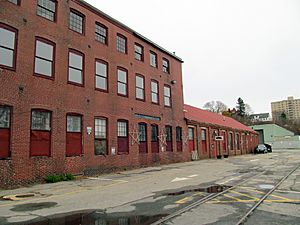Portland Company facts for kids
| Industry | Railroad Equipment |
|---|---|
| Founded | November 10, 1846 |
| Founder |
|
| Defunct | 1978 |
| Headquarters | , |
The Portland Company was a big factory that started on November 10, 1846. It was founded by John A. Poor and Septimus Norris, an engineer from Norris Locomotive Works. Their main goal was to build locomotives and other railroad equipment.
The factory opened in October 1847 in Portland, Maine. Their first locomotive, named Augusta, was finished in July 1848. Over many years, the Portland Company built more than 600 steam locomotives. They also made 160 ships for both trade and the navy. This included engines for Civil War gunboats like the Agawam and Pontoosuc.
Besides trains and ships, they also produced railcars, construction machines, and even Knox automobiles. This made the Portland Company one of the most important steel manufacturers in New England. The company stopped making things in 1978.
Today, the old Portland Company site is a busy area focused on the ocean. It has a small marina and offices for marine businesses. It is also home to the Maine Narrow Gauge Railroad Co. & Museum.
Contents
Building Big Locomotives
The Portland Company built many locomotives for the Atlantic and St. Lawrence Railroad. These trains were special because they ran on a wider track, called a 5-foot-6-inch gauge. This was different from the standard track width used in most places.
The company made many powerful locomotives for this railroad. They built trains with names like Montreal, Machigonne, and Coos. These locomotives helped connect Portland, Maine, to Montreal in Canada.
Smaller Locomotives for Narrow Tracks
In 1890, the Portland Company started making smaller locomotives. These were designed for "two-foot gauge" railroads. These tracks were much narrower than regular ones. The company used designs from another factory, Hinkley Locomotive Works.
Portland Company made these small locomotives even better. Their designs were very successful for Maine's narrow-gauge railroads. These trains had fancy Victorian details, like decorative domes and curved cab roofs.
The first of these narrow-gauge locomotives was very heavy and powerful for its size. Portland Company's locomotives became popular for carrying passengers. Later, bigger engines were built for freight. The Portland locomotives were then used for moving cars around train yards or on tracks that were not as strong.
The company also made many freight cars for these narrow-gauge railroads. They were the main supplier between 1890 and 1907. The last two-foot gauge locomotive built by Portland Company was a larger version of their original design.
Even after Portland Company stopped making locomotives, their designs lived on. Other companies built similar trains. Portland's basic locomotive design pulled the last trains on several narrow-gauge lines. This included the Kennebec Central Railroad in 1929 and the Monson Railroad in 1943.
Preserved Portland Locomotives
Some of the locomotives built by the Portland Company still exist today! They have been saved and can be seen in museums or on special railway lines.
| Serial number | Wheel arrangement (Whyte notation) |
Build date | Operational owner(s) | Disposition |
|---|---|---|---|---|
| 233 | 4-4-0 | 1872 | Grand Trunk Railway number 40 | Canada Science and Technology Museum |
| 622 | 0-4-4T Forney locomotive | 2 May 1891 | Sandy River Railroad number 5 Sandy River and Rangeley Lakes Railroad number 6 Kennebec Central Railroad number 4 Wiscasset, Waterville and Farmington Railway number 9 |
Wiscasset, Waterville and Farmington Railway |
Images for kids



